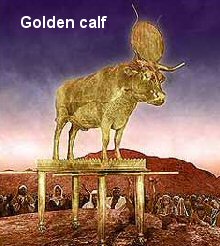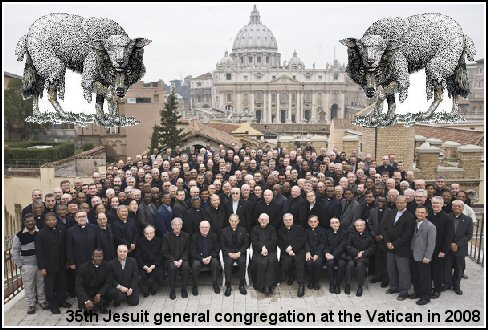"The Good Shepherd carrying the sheep on his shoulders occurs frequently, and this preference may well be dueto its resemblance to the SUN Worship figures of Hermes Kriophorus or Aristaeus, which at this period were much in vogue....Even the fable of Orpheus was borrowed pictoriallyand referred to Christ. Similarly the story of Eros and Psyche was revived and Christianized, serving to remind the believers of the resurrection of the body.. ..The group of the Twelve Apostles probably attracted the less attention because the twelve Dii Majores were often also grouped together. Again the figure of the Orans, the woman with arms uplifted in prayer, was quite familiar to classical antiquity....Similarly the fish symbol, representing Christ, the anchor of hope, the palm of victory, were all sufficiently familiar as emblems among SUN Worshipers to excite no particular attention.'
 In the
Old Testament, the apostasy into which the Israelites repeatedly
fell was that of mixture. Usually they did not totally reject the
worship of the true God, but mixed heathen rites with it!
This was the case even when they worshiped the golden calf (Exodus 32).
We all realize that such worship was false, heathenism, and an
abomination in the sight of God, Yet--and this is the point we
would make--it was claimed that this was a "feast unto the Lord"
(verse 5)--a feast to Jehovah (or more correctly) Yahweh, the true
God! They sat down to eat and drink and rose up to play.
They practiced rites in which they made themselves naked (verse
25), perhaps similar to those which were carried out by naked
Babylonian priests.
In the
Old Testament, the apostasy into which the Israelites repeatedly
fell was that of mixture. Usually they did not totally reject the
worship of the true God, but mixed heathen rites with it!
This was the case even when they worshiped the golden calf (Exodus 32).
We all realize that such worship was false, heathenism, and an
abomination in the sight of God, Yet--and this is the point we
would make--it was claimed that this was a "feast unto the Lord"
(verse 5)--a feast to Jehovah (or more correctly) Yahweh, the true
God! They sat down to eat and drink and rose up to play.
They practiced rites in which they made themselves naked (verse
25), perhaps similar to those which were carried out by naked
Babylonian priests.During the forty years in the wilderness, the Israelites carried the tabernacle of God. However, some of them were not content with this, so they added something. They made unto themselves a Babylonian tabernacle that was carried also! "But ye have borne the tabernacle of your Moloch and Chiun, your images" (Amos 5:26; Acts 7:42,43). These were but other names for the sun-god Baal and the mother goddess Astarte. Because of this mixture, their songs of worship, sacrifices, and offerings were rejected by God.
At another period, the Israelites performed secret rites, built high places, used divination, caused their children to pass through the fire, and worshiped the sun, moon, and stars (2 Kings 17:9-17). As a result, they were driven from their land. The king of Assyria brought men from various nations, including Babylon, to inhabit the land from which the Israelites had been taken. These also practiced heathenistic rituals and God sent lions among them, Recognizing such as the judgment of God, they sent for a man of God to teach them how to fear the Lord. "Howbeit every nation made gods of their own" (verses 29-31), attempting to worship these gods and the Lord also--a mixture: "So"--in this way--"they feared the Lord, and made unto themselves of the lowest of them priests...they feared the Lord, and served their own gods" (verse 32)!
Mixture was also apparent in the days of the Judges when a Levite priest who claimed to speak the word of the Lord, served in a "house of gods," and was called by the title "father" (Judges 17:5-13)
.
At the time of Ezekiel, an idol had been placed right at the entrance of the Jerusalem temple. Priests offered incense to false gods which were pictured upon the walls. Women wept for Tammuz and men worshiped the sun at dawn from the temple area (Ezekiel 8). Some even sacrificed their children and "when they had slain their children to their idols," God said, "then they came the same day into my sanctuary"
(Ezekiel 23:38,39),
Jeremiah's message was directed to people who claimed to "worship the Lord" (Jer. 7:2), but who had mixed in SUN Worship rites. "Behold," God said, 'ye trust in lying words that cannot profit. Ye...burn incense unto Baal, and walk after other gods and...make cakes to the queen of heaven..and come and stand before me in this house" (verses 8-18).
Considering these numerous Biblical examples, it is clear that God is not pleased with worship that is a mixture. As Samuel preached, 'If ye do return unto the Lord with all your hearts, then put away the strange gods and Ashtaroth (the SUN Worship mother worship) from among you, and prepare your hearts unto the Lord, and serve him only: and he will deliver you" (1 Sam, 7:3).

Because of the clever ways that SUN Worship was mixed with Christianity, the Babylonian influence became hidden--a mystery--"mystery Babylon." But as a detective gathers clues and facts in order to solve a mystery, so in this study we have presented many Biblical and historical clues as evidence. Some of these clues may have seemed insignificant at first glance or when taken alone. But when the full picture is seen, they fit together and conclusively solve the mystery of Babylon-ancient and modern! Over the centuries God has called his people out of the bondage of Babylon. Still today his voice is saying, "Come out of her, my people, that ye be not partakers of her sins" (Rev, 18:4).
It is a delicate task to write concerning religious subjects about which very fine and sincere people have strong differences. One wants to speak frankly enough to make a point, yet also to maintain a proper balance, so that in disagreeing he is not needlessly disagreeable. As with any book--certainly not excluding the Bible itself--it is inevitable that some misunderstanding or differences of opinion will result. Some may feel too much has been said, others not enough. Nevertheless, in the words of Pilate, "What I have written I have written." If the Roman Catholic Church, which claims to never change, is gradually turning from practices which are unscriptural, we can be glad for any progress along the path of truth. If this study has had any part in this trend, we can rejoice.
We believe the true Christian goal is not religion based on mixture, but a return to the original, simple, powerful, and spiritual faith that was once delivered to the saints. No longer entangling ourselves in a maze of rituals and powerless traditions, we can find the "simplicity that is in Christ," and rejoice in the "liberty wherewith Christ has made us free" from "bondage" (2 Cor. 11:3; Gal. 5:1). In American we hear the saying: "Freedom isn't free". No man or government can give you Freedom. The only Freedom and liberty is in Jesus Christ.
Salvation is not dependent on a human priest, Mary, the saints, or the Pope. Jesus said, "I am the way, the truth, and the life: no man cometh unto the Father, but by me" (John 14:6). Neither is there salvation in any other: for there is none other name under heaven given among men, whereby we must be saved" (Acts 4:12). Let us look to Him who is the Author and Finisher of our faith, the Apostle and High Priest of our profession, the Lamb of God, the captain of our Salvation, the Bread from Heaven, the Water of Life, the Good Shepherd, the Prince of Peace, the King of kings and Lord of lords--JESUS CHRIST.
“Signs and symbols rule the SUN Worship world, not
words nor laws.”
www.granddesignexposed.com
www.granddesignexposed.com